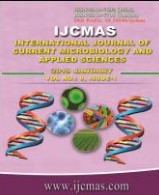


 National Academy of Agricultural Sciences (NAAS)
National Academy of Agricultural Sciences (NAAS)

|
PRINT ISSN : 2319-7692
Online ISSN : 2319-7706 Issues : 12 per year Publisher : Excellent Publishers Email : editorijcmas@gmail.com / submit@ijcmas.com Editor-in-chief: Dr.M.Prakash Index Copernicus ICV 2018: 95.39 NAAS RATING 2020: 5.38 |
Evaluation of different chickpea sowing technologies under paddy residue conditions was conducted in a harvested paddy field. Field of paddy was harvested with combine. Chickpea variety (JG-130) was sown with different farm machines in four treatments viz., T1: Happy seeder, T2: Zero till seed cum fertilizer drill, T3: Conventional seed cum fertilizer drill and T4: Raised bed seed cum fertilizer drill in harvested R-1 variety of paddy fields. In T1, all the paddy straw was remained in the field itself and spreaded uniformly. While in T2, T3 and T4, maximum loose paddy straw was removed manually for better operation of the machines. The maximum total yield of chickpea grain was obtained in treatment T1 (happy seeder, 1137.8 kg/ha) followed by treatment T4 (raised bed seed cum fertilizer drill, 1092.83 kg/ha) where as it was found to be minimum for the treatment T2 (zero till seed cum fertilizer drill, 1008.5 kg/ha) followed by treatment T3 (conventional seed cum fertilizer drill, 1067.29 kg/ha). The findings of the present study envisage that for feeding the ever growing population and to earn higher returns, farmers should adopt the recommended management practices for rice-chickpea cropping system.
 |
 |
 |
 |
 |